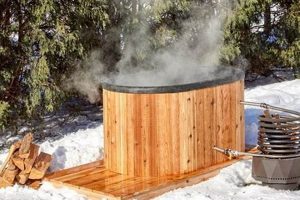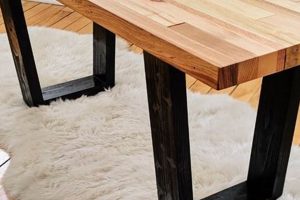Creating custom-colored finishes for wooden surfaces through homemade mixtures is a practice that allows for personalized aesthetics and cost-effective solutions. This involves combining readily available materials to achieve a desired hue and finish on wood, offering an alternative to commercially produced products. For example, using vinegar and steel wool can create a gray, aged appearance on wood.
The appeal of crafting individualized wood finishes lies in its ability to tailor colors precisely to match specific design requirements and material properties. Historically, natural substances like berries, roots, and minerals were employed to color wood. The resurgence of this approach reflects a growing interest in environmentally conscious practices, as homemade solutions often utilize fewer synthetic chemicals. This method facilitates a deeper connection with the materials and the creative process, producing unique and personalized results.
The following sections will explore various recipes, application techniques, and safety considerations necessary for achieving successful results when producing custom wood finishes. Detailed instructions and precautions will be provided to guide the reader through the process, ensuring a well-informed and effective approach.
Essential Guidance for Homemade Wood Finishes
Achieving professional-quality results with homemade wood finishes requires careful planning, preparation, and execution. The following tips offer critical guidance for a successful outcome.
Tip 1: Surface Preparation is Paramount: Proper sanding and cleaning are critical. Remove any existing finishes, dirt, or imperfections before applying the homemade mixture. Failure to do so can result in uneven color absorption and a compromised final appearance.
Tip 2: Test on Scrap Wood: Always test the mixture on a piece of scrap wood of the same species as the project piece. This allows assessment of the color, penetration, and drying time before committing to the final application.
Tip 3: Uniform Application is Key: Apply the mixture evenly, using a brush, rag, or sponge. Overlapping or uneven application can lead to blotchy or inconsistent color distribution.
Tip 4: Control the Saturation: Apply multiple thin coats rather than one thick coat. This allows for better control over the final color depth and prevents excessive saturation, which can obscure the wood grain.
Tip 5: Neutralize Acidic Solutions: If using acidic components like vinegar, consider neutralizing the wood surface afterward with a solution of baking soda and water to prevent further chemical reactions within the wood.
Tip 6: Allow Adequate Drying Time: Allow sufficient drying time between coats and before applying a topcoat. Insufficient drying can lead to tackiness, cracking, or peeling of the finish.
Tip 7: Proper Ventilation is Essential: Work in a well-ventilated area to avoid inhaling harmful fumes from the ingredients used in the homemade mixture.
The successful application of these principles ensures a consistent, durable, and aesthetically pleasing finish that enhances the natural beauty of the wood. Diligence in these steps minimizes errors and maximizes the potential of creating customized, high-quality wood finishes.
The concluding section will offer insights into various formulations and recipes for creating a range of custom wood finishes, providing practical examples to guide the reader through the process.
1. Color Pigment Selection
The selection of color pigments represents a foundational element in the creation of homemade wood finishes. The characteristics of the chosen pigment directly impact the resulting color, intensity, and longevity of the finish. Careful consideration must be given to the source, composition, and properties of the pigment to ensure a satisfactory outcome.
- Natural Pigment Sources
Natural pigments, derived from plants, minerals, or insects, offer a range of color options and often impart a subtle, earth-toned aesthetic. Examples include walnut hulls for brown tones, turmeric for yellow hues, and beet juice for reddish shades. The use of natural pigments aligns with environmentally conscious practices. However, the lightfastness and color stability of natural pigments can vary, potentially leading to fading or color shift over time. Mordants, such as vinegar or alum, are often necessary to improve pigment binding and permanence.
- Inorganic Pigment Considerations
Inorganic pigments, typically derived from metal oxides, provide superior color stability and lightfastness compared to natural alternatives. Iron oxides yield a range of yellows, reds, and browns, while titanium dioxide contributes a bright white. The use of inorganic pigments in homemade finishes requires careful consideration of safety. Some inorganic pigments may contain heavy metals or other potentially harmful substances, necessitating the use of appropriate safety precautions, such as wearing gloves and a respirator during handling.
- Pigment Particle Size and Dispersion
The particle size and dispersion of the pigment within the binder vehicle significantly influence the finish’s appearance and application properties. Finely ground pigments produce smoother, more even finishes, while coarser pigments may impart a textured effect. Proper dispersion of the pigment prevents clumping and settling, ensuring a uniform color distribution. Techniques such as grinding the pigment with a mortar and pestle or using a dispersing agent can improve pigment particle size and dispersion.
- Pigment Compatibility with Binder
The chosen pigment must be chemically compatible with the binder vehicle to ensure proper mixing, adhesion, and color development. Incompatible pigments may react with the binder, leading to color changes, precipitation, or poor adhesion. Testing the compatibility of the pigment and binder on a small scale is essential before committing to a large-scale application. Water-based binders are generally compatible with water-soluble pigments, while oil-based binders require oil-soluble pigments.
The careful selection of color pigments, considering their source, properties, and compatibility with the binder vehicle, directly determines the aesthetic quality and durability of the resulting homemade wood finish. Understanding these facets empowers individuals to create customized finishes that meet their specific design requirements and environmental considerations. Further experimentation and refinement of techniques can yield unique and personalized results, showcasing the inherent beauty of the wood.
2. Binder Vehicle Consistency
The consistency of the binder vehicle directly influences the performance and appearance of a homemade wood finish. The binder serves as the medium that carries the color pigment and adheres it to the wood surface. An improperly formulated binder vehicle can result in uneven color application, poor adhesion, and a compromised final finish. For example, a binder that is too thick may lead to streaking and brush marks, while one that is too thin may cause the pigment to separate and result in a weak, uneven color. Understanding the characteristics of different binder vehicles and their effect on consistency is crucial for achieving the desired results. Linseed oil, a commonly used binder, requires thinning with a solvent to achieve optimal penetration and leveling. Conversely, water-based binders may require thickening agents to prevent excessive absorption into porous wood species.
Practical applications of understanding binder vehicle consistency are evident in achieving specific aesthetic effects. A thinner consistency is preferred when highlighting wood grain, as it allows the pigment to penetrate deeply into the porous areas. Conversely, a thicker consistency is beneficial when creating a more opaque finish or when working with wood species that have a tendency to blotch. Experimentation with different binder vehicle formulations and ratios is essential to determine the optimal consistency for a given wood species and desired finish. This involves adjusting the proportions of binders, solvents, and additives to achieve the required viscosity and flow properties.
In summary, binder vehicle consistency represents a critical aspect of crafting successful homemade wood finishes. Careful attention to the properties of the binder vehicle and its interaction with the pigment and wood surface ensures a uniform, durable, and aesthetically pleasing result. Challenges may arise from the variability of raw materials and the complexity of wood characteristics, necessitating ongoing experimentation and refinement. Ultimately, mastering binder vehicle consistency contributes significantly to the broader goal of creating custom wood finishes that enhance the natural beauty and protect the integrity of the wood.
3. Wood Species Porosity
Wood species porosity significantly affects the absorption rate and evenness of penetration of homemade wood finishes. Variations in cell structure density and vessel size determine the degree to which a wood species absorbs liquid finishes. Highly porous woods, such as pine or birch, tend to absorb finishes quickly and unevenly, potentially resulting in blotchiness or excessive darkening. Conversely, denser, less porous woods like maple or cherry resist finish penetration, requiring careful application techniques to ensure adequate color absorption. Therefore, understanding the inherent porosity of a specific wood species is crucial for selecting appropriate homemade finish formulations and application methods to achieve a uniform and aesthetically pleasing result. For example, a finish formulated with a high binder-to-pigment ratio might be preferred for porous woods to control absorption, while a finish with a lower binder ratio could be suitable for denser woods.
Considerations for wood species porosity extend beyond the initial application of the finish. The long-term durability and color stability of a finish can be influenced by the wood’s porosity. Highly porous woods may exhibit greater susceptibility to moisture absorption, potentially leading to finish degradation or discoloration over time. Appropriate sealing and topcoat applications are essential to mitigate these risks, particularly in high-humidity environments. Furthermore, the choice of wood sealant should be carefully considered in relation to the finish formulation to ensure compatibility and optimal performance. For instance, a water-based sealant may be preferred for use with a water-based finish on a porous wood species to promote adhesion and prevent moisture-related issues. The combination of an oil-based stain and porous wood will lead to a poor appearance because the stain could be sucked up into the wood leading to inconsistencies in color.
In summary, wood species porosity plays a critical role in determining the outcome of homemade wood finishing projects. A thorough understanding of a wood’s absorptive characteristics allows for informed decisions regarding finish formulation, application techniques, and sealing strategies. Addressing porosity-related challenges proactively ensures a durable, aesthetically pleasing, and long-lasting finish that enhances the inherent beauty of the wood. The complex interplay between wood species porosity and diy wood finishes highlights the importance of meticulous planning and execution in woodworking endeavors.
4. Application Technique Mastery
The successful realization of homemade wood finishes is inextricably linked to proficiency in application techniques. The method of application significantly impacts the uniformity of color, depth of penetration, and overall aesthetic appeal of the final product. Consequently, mastery of various application techniques is paramount for achieving professional-quality results with custom wood finishes.
- Brushwork Precision
Brush application, a common method, necessitates precise control over brushstrokes to prevent streaking, uneven color distribution, and excessive buildup in corners or recessed areas. The type of brush, bristle material, and brush angle relative to the wood grain influence the final outcome. For example, a high-quality natural-bristle brush is generally preferred for oil-based finishes, while synthetic brushes are more suitable for water-based products. Overlapping brushstrokes can minimize inconsistencies, but excessive overlapping may lead to over-saturation and uneven drying.
- Rag Application Control
Rag application, often employed for achieving a subtle, controlled color wash, requires careful management of the rag’s saturation level and application pressure. Excessively saturated rags can lead to blotchiness, while insufficient saturation may result in streaking or incomplete color coverage. The choice of rag material, such as cotton or linen, also affects the absorption and transfer of the finish. For instance, a lint-free rag is essential to prevent unwanted fibers from being embedded in the finish. Applying the finish in overlapping, circular motions can help ensure even distribution.
- Spraying Technique Consistency
Spray application, whether utilizing compressed air or airless systems, demands consistent gun speed, spray pattern overlap, and distance from the wood surface. Variations in these parameters can result in uneven color distribution, runs, or orange-peel texture. Proper equipment calibration, including pressure settings and nozzle selection, is crucial for achieving a uniform spray pattern. Overlapping spray passes by approximately 50% can minimize inconsistencies and ensure complete coverage. Maintaining a consistent distance from the workpiece is essential to avoid uneven finish build-up.
- Wiping Stain Execution
Wiping stains require skill in both applying and removing excess stain to achieve the desired color depth and clarity. The timing of the wipe is crucial; wiping too soon removes too much stain, while wiping too late can lead to a muddy or obscured grain. The type of wiping material, often a clean, lint-free cloth, and the pressure applied during wiping influence the amount of stain retained by the wood. Moving with the grain during wiping ensures a smooth, even finish. For harder woods, leaving the stain on slightly longer before wiping can allow for better color penetration.
These application techniques, each demanding a unique set of skills and considerations, highlight the critical role of expertise in achieving successful homemade wood finishes. Proficiency in one or more of these techniques empowers individuals to achieve a broad range of aesthetic effects, tailor finishes to specific wood species, and overcome common challenges associated with DIY wood finishing projects. The capacity to adapt application techniques based on material properties and desired outcomes is a hallmark of experienced wood finishers.
5. Sealing Topcoat Protection
The implementation of a sealing topcoat represents a critical phase in preserving the integrity and enhancing the longevity of surfaces treated with homemade wood finishes. The application of a suitable topcoat establishes a protective barrier against environmental factors, physical abrasion, and chemical exposure, safeguarding the underlying finish from degradation and ensuring long-term aesthetic appeal.
- Moisture Barrier Formation
A primary function of a sealing topcoat is to create a moisture-resistant barrier that prevents water penetration into the wood substrate. Excessive moisture absorption can lead to swelling, warping, cracking, and discoloration of the wood, compromising the finish’s appearance and structural integrity. Topcoats formulated with water-resistant resins, such as polyurethane or acrylic, effectively minimize moisture ingress. For example, a polyurethane topcoat applied to a stained wooden table provides protection against spills and humidity, preventing water rings and warping. Failure to apply an appropriate moisture barrier can result in premature finish failure and wood damage.
- UV Radiation Mitigation
Prolonged exposure to ultraviolet (UV) radiation can cause fading, discoloration, and chemical degradation of wood finishes. Topcoats containing UV absorbers or blockers effectively mitigate these effects by selectively filtering harmful UV rays. Spar urethane, commonly used for marine applications, incorporates UV inhibitors to protect wooden surfaces from sun damage, preventing yellowing and cracking. In the absence of UV protection, stained wood exposed to sunlight will exhibit noticeable fading and color alteration over time.
- Abrasion Resistance Enhancement
The application of a durable topcoat significantly enhances the abrasion resistance of wood finishes, protecting the underlying finish from scratches, scuffs, and wear. Topcoats formulated with hard resins, such as acrylic or epoxy, provide a resilient surface that withstands physical contact and friction. For instance, an epoxy topcoat applied to a stained wooden floor provides superior resistance to scuffs and scratches from foot traffic, maintaining its aesthetic appeal for extended periods. Inadequate abrasion resistance results in visible wear and tear, detracting from the appearance and value of the finished wood.
- Chemical Resistance Provision
Sealing topcoats can provide resistance against chemical exposure, safeguarding wood finishes from damage caused by solvents, acids, and other corrosive substances. Topcoats formulated with chemically resistant resins, such as epoxy or phenolic, effectively prevent chemical penetration and degradation. Application to a stained wooden laboratory bench protects the wood from spills of acids and solvents, preventing staining, discoloration, and structural damage. The lack of chemical resistance can result in irreversible damage to the finish and underlying wood substrate, necessitating costly repairs or replacements.
These protective attributes of sealing topcoats collectively contribute to the extended lifespan and sustained aesthetic appeal of wood surfaces treated with homemade wood finishes. The diligent selection and application of a suitable topcoat are crucial for maximizing the investment in both materials and labor, ensuring enduring protection and enhancing the inherent beauty of the wood.
6. Lightfastness Durability
Lightfastness durability, concerning homemade wood finishes, directly relates to the stain’s resistance to fading or color change when exposed to light, particularly ultraviolet (UV) radiation. Homemade wood stains, often formulated with natural or unconventional pigments, exhibit varying degrees of lightfastness. Pigments derived from organic sources may degrade under prolonged light exposure, leading to a gradual shift in hue or a reduction in color intensity. This phenomenon contrasts with commercially produced stains, where synthetic pigments are frequently chosen for their superior lightfastness characteristics. The selection of pigments significantly impacts the long-term appearance and aesthetic value of the stained wood surface. Example: A stain made with beet juice will fade quickly under sunlight, while one with iron oxide will remain longer.
The durability aspect further intertwines with lightfastness. A finish prone to fading is inherently less durable because its visual integrity is compromised. Environmental factors exacerbate this issue; fluctuations in temperature and humidity can accelerate pigment degradation and weaken the bond between the stain and the wood. To mitigate these effects, protective topcoats containing UV inhibitors are frequently employed. These topcoats act as a barrier, filtering out harmful radiation and reducing the rate of pigment breakdown. The practical application involves carefully selecting finish components known for UV resistance and applying them in multiple layers to maximize protection.
In summary, lightfastness durability constitutes a critical consideration when creating homemade wood stains. The choice of pigments, coupled with appropriate sealing and topcoat protection, determines the longevity and visual appeal of the finished wood surface. While challenges exist in achieving the same level of lightfastness as commercially produced stains, a thorough understanding of material properties and protective measures enables the creation of durable and aesthetically pleasing wood finishes. This intersection of lightfastness and durability is key to preserving the desired aesthetic over extended periods.
7. Cost-Effective Sourcing
The cost-effective sourcing of materials forms a cornerstone of the “diy wood stain” approach, directly influencing its accessibility and economic viability. The primary cause lies in the potential for significant cost reduction compared to purchasing commercially prepared wood stains. This effect stems from utilizing readily available materials or inexpensive alternatives to proprietary chemical formulations. For example, employing household items such as vinegar, coffee grounds, or steel wool to create a weathered gray finish reduces material expenses dramatically. This approach leverages the principle of resourcefulness, transforming common substances into functional and aesthetic finishing agents. Without cost-effective sourcing, the inherent advantage of creating personalized wood finishes is diminished, potentially rendering the “diy wood stain” process less attractive to budget-conscious individuals.
The practical significance of understanding cost-effective sourcing extends beyond mere financial savings. It promotes resourcefulness and reduces reliance on commercially manufactured products, which often entail complex supply chains and environmental concerns. Examples include substituting traditional chemical dyes with natural pigments derived from plants or minerals, thereby minimizing environmental impact. Furthermore, understanding the properties of different materials and their suitability for creating wood finishes allows for informed purchasing decisions. For instance, bulk purchasing of essential ingredients, such as linseed oil or beeswax, can further reduce costs while ensuring a consistent supply for multiple projects. The knowledge gained from cost-effective sourcing can be applied to a wider range of DIY endeavors, fostering a culture of sustainability and self-sufficiency.
In summary, cost-effective sourcing is an indispensable component of “diy wood stain,” driving its economic appeal and promoting environmentally conscious practices. Challenges may arise in identifying reliable and consistent sources for natural pigments or alternative materials. However, the benefits of reduced costs, environmental responsibility, and increased self-sufficiency underscore the importance of prioritizing cost-effective sourcing strategies within the broader context of creating personalized wood finishes. This approach not only enhances the affordability of woodworking projects but also aligns with the growing demand for sustainable and responsible consumption.
Frequently Asked Questions about diy wood stain
This section addresses common inquiries regarding the creation and application of homemade wood finishes, providing concise and informative answers to assist in achieving successful outcomes.
Question 1: What are the primary advantages of creating a finish oneself compared to purchasing commercial products?
The primary advantage lies in the ability to customize color precisely, reduce costs by utilizing readily available materials, and minimize exposure to potentially harmful chemicals found in some commercial products. It also provides an opportunity to engage in a creative process and achieve unique aesthetic results not easily replicated with mass-produced finishes.
Question 2: What safety precautions should be observed when working with homemade wood finishes?
Adequate ventilation is paramount to prevent inhalation of fumes. The use of protective gloves and eye protection minimizes skin and eye contact with potentially irritating or corrosive substances. Proper disposal of materials, particularly those containing flammable solvents, is essential to prevent fire hazards.
Question 3: How can blotchiness be prevented when applying to porous wood species?
Pre-sealing the wood with a sanding sealer or diluted varnish can reduce the wood’s absorbency, leading to a more uniform stain application. Alternatively, using a gel stain or applying multiple thin coats of the can also minimize blotchiness. Careful sanding and surface preparation are also important factors.
Question 4: What are some common household ingredients that can be used to create custom colors?
Vinegar and steel wool can produce a gray, aged appearance. Coffee grounds can impart a brown tint. Tea bags can create a warm, antique effect. Beet juice can be used for reddish hues. The concentration and application method influence the final color intensity.
Question 5: How does wood species affect the final color?
Different wood species exhibit varying degrees of porosity and inherent color tones, influencing how they absorb and display wood finish. A finish applied to pine will appear different than on oak or maple. Testing on scrap wood of the same species is crucial to assess the final color and penetration.
Question 6: What type of topcoat is recommended for protecting homemade wood finishes?
The selection of a topcoat depends on the intended use of the finished piece and the desired level of protection. Polyurethane provides excellent durability and water resistance. Lacquer offers a smooth, fast-drying finish. Varnish provides good protection against moisture and UV damage. Ensure the topcoat is compatible with the finish.
These responses provide foundational knowledge for crafting personalized wood finishes, emphasizing safety, preparation, and material considerations. Continued research and experimentation are encouraged to refine techniques and achieve desired aesthetic outcomes.
The following section will provide a summary of the key steps involved in achieving a professional-grade diy wood stain.
Conclusion
This exploration of “diy wood stain” has illuminated critical aspects, from pigment selection and binder consistency to wood species porosity and application mastery. Attention to detail during each stageincluding rigorous surface preparation, lightfastness considerations, and cost-effective sourcingdictates the final outcome. These elements coalesce to determine the long-term durability and aesthetic appeal of the finished wood surface.
The information presented serves as a foundation for informed experimentation and refinement of techniques. Continued diligence in material selection, application methods, and protective topcoat implementation will enable the creation of personalized, high-quality wood finishes. The successful adoption of these principles allows for both aesthetic control and a reduction in reliance on commercially produced products, fostering sustainable practices within woodworking endeavors.



![[DIY Guide] Easy DIY Wood Window Shutters You Can Build! The DIY Hub: Creative Crafts, Repairs & Life Hacks [DIY Guide] Easy DIY Wood Window Shutters You Can Build! | The DIY Hub: Creative Crafts, Repairs & Life Hacks](https://craftingdiycenter.com/wp-content/uploads/2025/07/th-3579-300x200.jpg)



